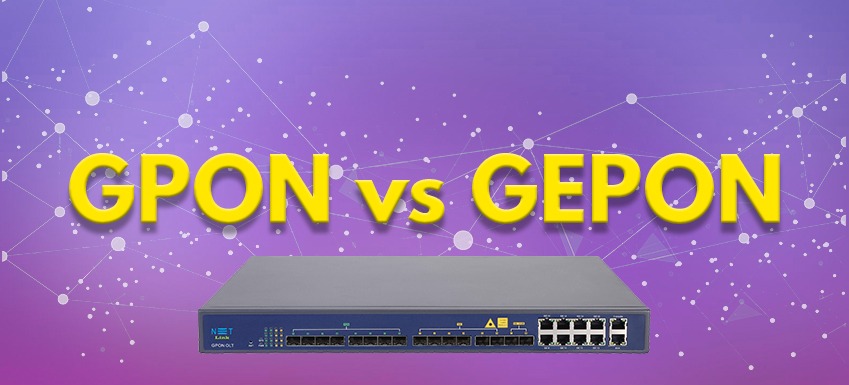GPON Vs EPON, What Is The Difference? Leave a comment
EPON and GPON each have their own advantages. GPON is superior to EPON from the performance index. However, EPON has the advantage of time and cost. GPON is catching up and looking forward to the future broadband access market. GPON will be more suitable for customers with high bandwidth, multi-service, QoS and security requirements and ATM technology as the backbone. This article will do a detailed comparison of the differences between EPON and GPON.
GPON vs EPON: Data Rate
GPON: GPON supports a variety of data rate levels, which can support asymmetric uplink and downlink rates, downlink 2.5Gbps or 1.25Gbps, uplink 1.25Gbps or 622Mbps. Users can determine uplink and downlink rates according to actual needs and select the corresponding optical transceiver to improve the optical device value for money.
EPON: EPON provides fixed uplink and downlink data rate of 1.25Gbps, using 8b / 10b line coding, and the actual rate of 1Gbps.
Conclusion: GPON is better than EPON
GPON vs EPON: Splitter Ratio
GPON: GPON supports 1:32, 1:64, 1:128. GPON provides multiple selectivities, but its cost advantage is not obvious. The maximum physical distance that a GPON system can support is 20 km when the optical splitting ratio is 1:16. When the optical splitting ratio is 1: 32, the maximum physical distance should be 10 km.
EPON: EPON standard splitter ratio is 1:16~1:32. In fact, the EPON system can also achieve higher splitter ratio, such as 1: 64,1: 128, EPON OLT can support more EPON ONU. The splitter ratio is mainly limited by the performance of the optical module. A large splitter ratio can cause the cost of the optical module to increase substantially. In addition, the PON insertion loss is 15-18 dB, and the large splitter ratio reduces the transmission distance; too many users share Bandwidth is also the cost of large splitter ratio.
Conclusion: equal
GPON vs EPON: QoS(Quality of Service)
GPON: GPON divides the service bandwidth allocation into four types. The priorities are Fixed, Assured, Non-Assured, and Best Effort from highest priority to lowest priority. The DBA defines a traffic container (T-CONT) as an uplink traffic scheduling unit, and each T-CONT is identified by an Alloc-ID. Each T-CONT can contain one or more GEMPort-IDs.
T-CONT is divided into five types of services. Different types of T-CONTs have different bandwidth allocation modes to meet the different QoS requirements of different service flows such as delay, jitter, and packet loss rate.
- T-CONT type 1 is characterized by a fixed bandwidth fixed time slot corresponding to a fixed (Fixed) allocation, suitable for delay-sensitive services such as voice services
- Type 2 is characterized by a fixed bandwidth but the slot is not guaranteed, the corresponding guaranteed bandwidth (Assured) allocation, suitable for jitter less demanding fixed-bandwidth services, such as video-on-demand services;
- Type 3 is characterized by a minimum guaranteed bandwidth and can dynamically share the remaining bandwidth, and the maximum bandwidth constraints, corresponding to non-guaranteed bandwidth -Assured), which is suitable for services that have service assurance requirements and burst traffic, such as downloading services.
- Type 4 is characterized by BestEffort and without bandwidth guarantee, which is suitable for less delay and jitter requirements Of the business, such as WEB browsing business;
- Type 5 is a combination of types, after the allocation of assurance and non-guaranteed bandwidth, the extra bandwidth needs to make every effort to allocate.
EPON: EPON adds a 64-byte MPCP multipoint control protocol at the MAC layer Ethernet header. MPCP controls the access to the P2MP point-to-multipoint topology through messages, state machines, and timers to achieve dynamic bandwidth allocation for DBAs. MPCP involves the allocation of time slots for ONU transmission, automatic discovery and joining of ONUs, and reporting of congestion to higher layers to dynamically allocate bandwidth. MPCP provides basic support for the P2MP topology. However, the protocol does not classify the priorities of services. All services compete for bandwidth randomly. GPON has a better DBA and excellent QoS services.
Conclusion: GPON is better than EPON
GPON vs EPON: Operate and maintain OAM
GPON: GPON defines PLOAM (Physical Layer OAM) at the physical layer, OMCI (ONT Management and Control Interface) at the upper layer, and OAM management at multiple levels. PLOAM for data encryption, status detection, error monitoring and other functions. The OMCI channel protocol is used to manage the services defined by the upper layer, including the ONU function parameter set, the type and quantity of T-CONT services, QoS parameters, request configuration information and performance statistics. The OMCI channel automatically notifies the system of running events, Troubleshooting, performance and safety management.
EPON: EPON does not overemphasize OAM, simply defines the ONT far-end fault indication, loopback, and link monitoring, and is optional support.
Conclusion: GPON is better than EPON
GPON vs EPON: Link layer encapsulation and multi-service support
GPON: GPON is based on a completely new Transport Convergence (TC) layer that can accommodate high-level diversity services as shown in Figure 1. ATM encapsulation and GFP encapsulation (Universal Framing Protocol) is defined, and both can be chosen One of the business packages. In view of the fact that ATM applications are not popular at the moment, a GPON supporting only GFP encapsulation is therefore available. the lite device came into being, it ATM from the protocol stack to reduce costs.
EPON: EPON follows the simple Ethernet data format, but adds a 64-byte MPCP point-to-multipoint control protocol in the Ethernet header to realize the bandwidth allocation, bandwidth round robin, automatic discovery and ranging in the EPON system. Much research has not been done on the support of services other than data services such as TDM synchronization services. Many EPON manufacturers have developed some non-standard products to solve this problem, but they are not ideal and it is difficult to meet carrier-class QoS requirements.



